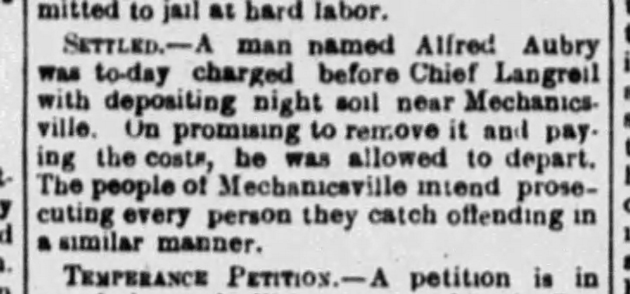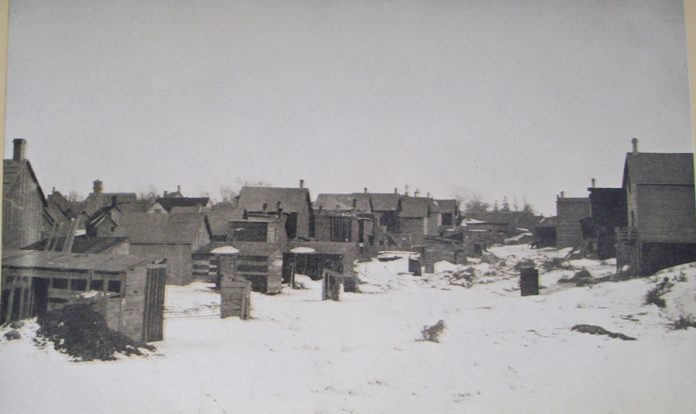By Dave Allston
Every home in Kitchissippi has a bathroom. Most probably have two or three or more—ensuites, powder rooms, guest baths and beyond—all evidence of the luxuries of 21st-century life. I often wonder how great it would be to time travel and live 100 or 200 years ago. Daydreaming is one thing, but would it actually be that great? The topic of Early Days this month may definitely ruin that time-travelling fantasy.
Prior to the elaborate sewage systems that modern cities now have, there existed elaborate, largely archaic, contentious and definitely unhealthy systems for dealing with human waste. This was the era of the “night soil.”
Locally, this era wasn’t too long ago when you consider that in many parts of Kitchissippi, sewer systems have been in place only 70 years or less. Prior to sewers, most houses had outhouses in the backyard. For tenement houses or multi-unit apartments, the outhouse was shared by many families. Once full, it required cleaning out or was simply covered with dirt and the outhouse moved.
Cleaning out was critical—just no one wanted to discuss it or see it. What was cleaned out was called “night soil.” As the name suggests, the waste was emptied by a crew of workers in the middle of the night, operating out of sight (and smell) of nearby residents.
This wasn’t anyone’s dream job, but it paid well and was not overly demanding (if you could stand the sights and smells). The operation usually had a team of four: one who was the “hole man” who went into the space to scoop the waste into a bucket or pail; a “rope man” who hauled the bucket up; and then two “tub men” who carried the bucket to the wagon.

Homeowners would pay a fee to have their privy emptied, and collection would typically occur throughout the winter (it was likely easier to remove when frozen?).
But where did this night soil end up? Believe it or not, back in the mid-1800s, the solution was simple—it was simply deposited into the Ottawa River, Rideau River or the Rideau Canal! And in the wintertime? It was simply piled on the ice surface, until the ice broke in the spring.
Water distribution arrived in Ottawa in 1874, powered by the hydraulic energy of the Chaudière Falls, and sewer systems came soon after. But it was a very slow and gradual process: it would take decades to get to some areas.
Ottawa would continuously struggle with methods of how to collect, transport and dispose of its night soil. In 1879, the city acquired an “odourless excavator” that worked between 7 a.m. and 7 p.m., which made many uncomfortable seeing the carts travelling over city streets in the daytime. Purchase of an incinerator—as Montreal had built—was seriously explored in the late 1880s but deemed too costly.
The onus was on individual citizens to manage their night soil. Those who could afford it would hire night soil men. Others would come up with their own methods of disposal. The city lacked the foresight to install a system to remove all waste, not just for those willing to pay for it. Thus, the city’s waste began appearing on farms, or on the roadside leading into the city.
Hintonburg and areas west in Kitchissippi were a long ways away from sewers, and, aside from the issues of disposal of waste of its own residents, Kitchissippi found itself as the primary dumping ground of Ottawa’s waste during its transition to sewers in the 1870s to 1890s.
The night soil men of Ottawa often came west to areas just outside of the city limits to discard the waste. Mechanicsville was a favourite dumping spot.
In September 1871, it was reported that, in the swamp behind Judge Armstrong’s residence (still standing today at Armstrong and Garland), “the mortal remains of some old horses and half a dozen barrels of night soil or so, are fertilizing the locality, and making the atmosphere all round smell anything but sweet.”
Throughout Kitchissippi ran a major creek system known as Cave Creek, which flowed in multiple branches to the Ottawa River from south of Carling Avenue. Those living alongside it built outhouses along or even overtop the creek, allowing waste to enter directly into it. Anyone living at the north end of the creek would have been subject to some terrible sights and smells. Later, when the typhoid epidemic hit Ottawa in 1911, Cave Creek was cited as one of the main reasons, referred to as “a sewer of the crudest and most dangerous type.”
Meanwhile, Gloucester and Nepean townships began to fight back against the dumping of the waste into the vacant fields of the townships.
In 1886, a deal was struck with the federal government to allow the Experimental Farm to be used for depositing. Trenches were constructed and the city’s waste that winter was transported to the Farm. However, by May 1887, the feds had changed their minds, and cancelled the deal.
Instead, the city looked back to…Kitchissippi! Andrew Holland had just a month prior acquired the Hinton farm but had little interest in farming. He was more interested in the long-term real estate value of the land. So he had no problem making a deal with Ottawa’s Medical Health Officer to allow the city to use the south end of the farm as the new dumping ground.

And so it began in the summer 1887, at the appropriately-called “rear end” of Holland’s farm, that the city’s waste began to arrive. While teams were out collecting the night soil, one man worked the fields making trenches in order to deposit it. Once filled, the pits were covered over and “intelligently treated” to prevent odours. Today’s homeowners at the south end of lot 35 (the area between Harmer and Parkdale just north of Carling, around Ruskin and Kenilworth) who have particularly fertile gardens now perhaps know part of the reason why!
The new system was not without fault. Hintonburg residents complained that the carting of the waste was being done carelessly along Richmond Road through the village, and the wagons and barrels were not deodorized property (as was required). Residents also complained that the night soil was being “scattered broadcast over the fields” and draining to the adjoining Cave Creek, which ran throughout the community. At one point, Holland himself was even charged with creating a nuisance for allowing the city waste to come to Hintonburg.
This process continued into 1889, at which time Nepean Township toughened up, passing a bylaw limiting the transportation and disposal of night soil and banning dumping on the Holland farm.
After Hintonburg became an independent village in 1893, politics were at play. After Nepean hesitated to allow Hintonburg to dump their night soil in the township fields, Hintonburg refused to allow Nepean to cart Mechanicsville’s waste through Hintonburg to get to Richmond Road. So, Nepean dumped Mechanicsville’s waste into the Ottawa River. It was a messy battle.
In 1898, farmers along Richmond Road west of Hintonburg had received approval from the Nepean Board of Health to obtain night soil from Mechanicsville and Hintonburg and spread it on their farms for fertilization purposes. However, homeowners in Hintonburg and Westboro complained of the odours and, more concerningly, the sudden appearance of diphtheria in the villages, which threatened an epidemic.
Following the opening of the Britannia streetcar line in 1900, cottage communities such as Champlain Park, Westboro and Woodroffe began to grow due to their proximity to the River. Of course, all suffered from the same problems that plagued early Ottawa, with privys and cesspools being dumped in the river. Thorough testing of the raw River water in 1912 from Hintonburg to Woodroffe was shown to have “extreme contamination.”
Nepean continued to employ a night soil man into the early 1950s. Dougal Mackenzie, who lived on Royal Avenue, was Nepean’s “honey wagon” driver from 1910 until the early 1950s. He not only emptied privys, but also septic tanks and pails used in temporary indoor toilets.
The logistics and costs of getting the neighbourhoods connected to sewers was a massive one, and it was not until the 1950s that most of Westboro and McKellar Park were finally connected.
For many years, Nepean dumped its night soil in a large permanent cesspool near Copeland Park, between Baseline and the Queensway. One of the last areas to receive plumbing in the west end was in the Bell Town neighbourhood, which still had outhouses (and septic tanks were forbidden) until the late 1960s.
Meanwhile, in Ottawa, the role of the collector began to diminish. There were still 1,600 homes not connected to sewers in 1913, but just 40 by 1928.
Older homes were updated to accommodate the new sewer and water services. Small closets were converted to bathrooms (hence where the name “water closets” is derived). Often, one small closet was converted to just a toilet room, and another closet had a sink and tub added. Some older houses in our neighbourhood still have these interesting features.
The toilet and sewer technology introduced in the 1920s is still largely the system we use today, and we can appreciate it all the more when remembering back to the headaches of night soil and its disposal in the early days of Kitchissippi!
